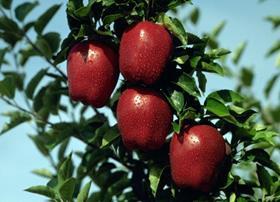
All the stars appear to be aligned for a record US apple season in India in 2010/11, thanks to low domestic apple stocks, high cost prices for competing Chinese apples and a Washington crop that is leaning towards the smaller sizes that India prefers.
Washington apple exports to India, which are still heavily dominated by Red Delicious, got off to a blistering start this season. While the peak marketing period does not usually commence until January, exports began pouring over to India in September this year. As of the end of October, India has already taken around 122,000 cartons of Washington apples, up by around 50 per cent on the same point last year.
“Fruit has been well accepted here in India with brisk movement,” said Gagan Khosla of major Indian fruit importer NGK Trading.
Shipments have slowed down in the past month, however, as demand for Washington apples ramps up for South East Asia ahead of the upcoming Chinese New Year festivities, according to Mr Khosla.
“The demand surge from South East Asia has pushed up prices and limited the available supply,” he told Fruitnet.com. “A clearer picture will emerge after 12 January once the Chinese New Year shipments are done. We’ll have to see how the market reacts once the higher priced fruit arrives on the market in two weeks.”
Indian demand for imported apples should be strong from January onwards as storage levels of local apples are low this season, according to Hitin Suri of Suri Agrofresh, one of the country’s top apple distributors.
“The fresh Himachal `Pradesh` apples are now finished and the amount of fruit in storage is only 20 per cent of the usual levels. That’s because prices were high for quality apples while the season was running,” he said. “Although the price of fruit was high, reasonable profits were made because the Kashmir apple crop had problems with black mite.”
Jammu & Kashmir, which along with Himachal Pradesh, is the other major source of domestic apples, has experienced a challenging season marked by climatic setbacks and disease pressures. In particular, traders are reporting widespread problems with scarring and blemishing of the fruit due to apple scab or black spot disease. As a result, very little fruit is suitable for storage in cold rooms.
“Good quality Kashmir apples are rare and they’re fetching a good price,” said Mr Suri, who estimates that only 40 per cent of India’s cold room capacity for apples has been used this year.
While a strong window of opportunity looks set to open up for imported apples moving into 2011, Chinese exporters do not appear to be in a position to capitalise. Although Chinese Fuji apples have gained a firm following among Indian consumers over the past few years, prices have escalated this season amid pressures on supplies. “Current prices of Chinese Fuji are around US$26-28 per carton CNF,” said Mr Khosla. “That’s expensive – and if you want fruit with full blush, it’s US$2 `per carton` more.”
The price hike on Chinese Fuji appears to be driven by a combination of rising domestic demand, shorter supplies (particularly of the blushed Fuji that India prefers) and a strong Chinese currency.
Indeed, Chinese Fuji is now comparatively more expensive than Washington Red Delicious. Class 1 Washington Reds are currently selling for US$26.50 per carton CNF and wholesaling for around Rs1,950-2,000 (US$43-44) per carton, according to Mr Khosla.
If Washington can maintain adequate supplies and competitive pricing in 2011, the prospects of a record season appear bright. While the 2009/10 Washington State apple crop erred towards large sizes, this year’s size profile is weighted towards smaller fruit, with the Red Delicious crop reportedly peaking on 113s. That is good news for exports to India, where the general preference is for smaller fruit, particularly in the southern regions.
Anecdotal reports in the trade suggest that Washington apple exports to India could hit a record 2m cartons in 2010/11. Shipments last year reached record levels through May but then fell away as supplies ran out, finishing at 1.385m cartons. The previous record is still held by the 2008/09 tally, which reached 1.852m cartons.






No comments yet